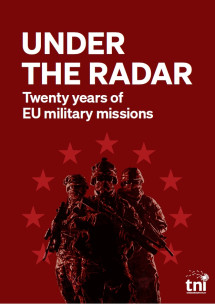Saudi Arabia was the third largest military spender in the world in 2017
According to a recent article of Pieter D. Wezeman (SIPRI) seven of the 10 countries in the world with the highest military burden in 2017 were in the Middle East, Saudi Arabia being the country with the highest levels of military spending and arms imports in this region.
As P. Wezeman states in his article, the lack of transparency in military matters makes it difficult to determine the extent to which Saudi Arabia’s high levels of military spending and arms procurement are driven by defensive or offensive motives, military or prestige considerations, internal power play or the possibility for government officials to enrich themselves. However, it is clear that Saudi Arabia is not just stocking up weapons. It is actually using them on a large scale in the offensive operation in Yemen. Preparations for the future use of armed force elsewhere should not be excluded as a motive for the continuing high level of militarization, says Wezeman.
Saudi Arabia has been leading the coalition of states in the military intervention against rebel forces in Yemen. Saudi Arabia is also militarily involved in other conflicts—such as providing support for rebel groups in Syria, attempting to use military assistance to gain influence in Lebanon and fighting Shiite minority groups in the eastern province of Saudi Arabia, according to Wezeman’s paper. Although the various conflicts throughout the Middle East are complex, it is widely believed that they can be at least partly explained by regional power struggles (such as those between Saudi Arabia and Iran, and Saudi Arabia and Qatar) or involving Israel, Turkey, the United Arab Emirates and the United States. Further proxy wars similar to those in Syria or Yemen—or even a direct confrontation between Saudi Arabia and its allies, and Iran and its allies—remain a possibility.
SIPRI estimates that Saudi Arabia was the third largest military spender in the world in 2017 and by far the largest military spender in the Middle East. Figures for Saudi Arabian military spending are however estimates, because Saudi Arabia’s public documents on budgets and actual spending contain only a minimal amount of information on military spending.
According to Wezeman’s paper, Saudi Arabia was the second largest arms importer in the world in the period 1998–2017. There was a low point in the period 2000–2008 when the country’s armed forces integrated large volumes of weapons that were ordered in the aftermath of Iraq’s invasion of Kuwait in 1990–91 and delivered in the late 1990s. This was followed by a steep increase in the volume of arms imports in 2013–2017. In 2013–17, 61 per cent of Saudi Arabia’s arms imports came from the USA and 23 per cent from the UK. Several other West European countries supplied most of the rest (see image above, taken from the SIPRI article).





